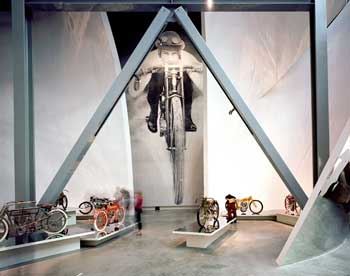The Guggenheim has moved into the Venetian—a Las Vegas hotel/casino—with not one, but two museums: Guggenheim Vegas for large-scale contemporary art, and Guggenheim Hermitage for Russia’s cache of Picassos, Cézannes and other early moderns. Taking the hit in its allotted space is the Hermitage collection, which comes across tackier than tattoos.
Your first impression begins with the approach route from the casino. To get to the museum, you must cut across a 120,000-square-foot gaming floor ablaze beneath hand-blown Italian glass chandeliers, where bettors with toneless stares play against 2,200 slot machines or lay odds in a palatial Baccarat pit. From there, you traverse a "grand corridor" full of towering fake marble pillars and fake marble statuary under a vaulted ceiling overspread with fake, gold leaf-framed Tiepolo frescoes. And then you‘re there—at the Guggenheim Hermitage.
And what do you see? Forty-five easel original paintings by the world’s most celebrated Impressionists and Post-Impressionists clinging to rusted Cor-Ten steel walls with magnets.
Compared to a casino the size of a large Venetian palazzo, the rusted steel space, measuring only 7,500 square feet, can strike one as a backroom. And when stacked against the hotel/casino’s glaringly-lit geegaws, the modest-sized paintings stuck onto dulling brown walls resemble the contents of an old stamp album.
 |
| Pablo Picasso, Three Women, 1908. |
|
What will the uninitiated think? How can, say, Picasso’s Three Women, a painting that heralded the start of Cubism—something most Americans won’t see unless they journey to the State Hermitage Museum in St. Petersburg, Russia—prompt in-drawn gasps if the burnt-sienna walls render Picasso’s sublime amber palette near invisible? In its dirt-colored surroundings, this icon of earth women gives the impression of a mud bath.
Just the opposite can be said of the monumental 63,000-square-foot, 70-foot-high Guggenheim Vegas and its display of 130 actual motorcycles. The space, located between the hotel and its parking garage—also steel-walled, but enhanced by Frank Gehry’s signature stainless steelwork, curved like rolling hills—outshines the Guggenheim Hermitage. And for what? Bikes?
 |
| The Art of the Motorcycle, The Venetian Resort Hotel and Casino. |
|
This is not to say that the architecture of the Guggenheim Hermitage is without a rationale. Masterbuilder Rem Koolhaas, last year’s Pritzker Prize winner, had the right idea. Call it the anti-Vegas aesthetic. The idea was to avoid competing with the architectural excess of the hotel/casino. After all, his reasoning went, how can you top Vegas’ muchness? To set the treasure house apart from the theatrical glitz, he sought the look of a "strongbox" to protect art’s aura and make it special.
But what you get is art made dead. What you get is a graceless mausoleum.
The Guggenheim started out in 1937 with four goals: collect, present, interpret and preserve. The Guggenheim Hermitage won’t be collecting or preserving. It will only be presenting. And unless visitors ante up some $50 for an exhibit catalog, they won’t get much interpretation, either. Labels for the exhibit examples offer tombstone information—names, dates—nothing more.
Fulfilling one out of four of the museum’s avowed goals does not a Guggenheim make.
And by the way Russia’s treasures look, even presentation is lacking. Allowing the steel walls to rust had a rationale that doesn’t wash any more than the rationale for the strongbox. The oxidized surface is supposed to conjure up the velvet walls of Russia’s Hermitage. It doesn’t. Instead, it evokes the walls at Las Vegas’ McCarran International Airport. On the airport, brown looks good. It quiets, represses the jitters. At the museum, it represses the energy of the work.
One also wonders if the idea of mounting original art in a place with so much faux art is a good idea. Won’t Vegas revelers, habituated by pretend this and that—look upon the real thing as just more make-believe?